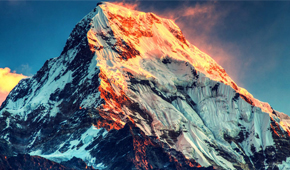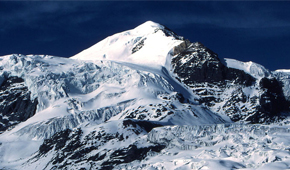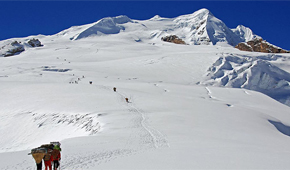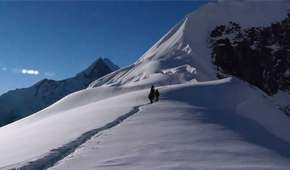Everest Expedition 8848M
Mount Everest is the highest Mountain of the World. It has unique beauty, mystery and mood. Successful historical Everest Expeditions leaves one with the sense of most proud and adventurous person on Earth. Mt. Everest's local names give you a sense of how the mountain commands respect from all who see her. Standing incredibly tall silhouetted against the shared sky of Nepal and Tibet, this mountain has many names: Chomolungma, Sagarmatha, Qomolungma or Mt. Everest. Whichever name one chooses, its vagueness still lives on. Most of the mountaineers have their dream to reach the summit of Everest in their life time. For many who are mainly trekkers become contended having the good view of it from Kala Pattar, Gokyo Ri or visiting Everest base camp.
The South Col route on the Nepalese side of Mt. Everest is the way taken by late Sir Edmund Hillary and Tenzing Norgay Sherpa first climbed it in 1953. Possibly the most colorful story about the early attempts on Everest is the one involving Captain J. Noel and his native companions. He disguised himself as a Mohammaden and made a journey from Darjeeling through Northwest Sikkim and round the north of Kanchanjunga in an attempt to reach Everest. Unfortunately, not even the disguise could see him through. His mission was out short just sixty-five km from Everest when a posse of Tibetan soldiers forced them to turn back. Although there are a dozen or so routes on Mt. Everest we follow the classical route, traditionally the most reliable way to the summit. Climbing Everest expedition has been successfully organized and climbed many times since then, but this should not lull prospective Everest climbers into complacency. Everest is a deadly mountain. Noting this, one cannot approach the mountain with anything but a serious determination and focused mountaineering attitude. Everest is still as inexplicable, beguiling and magnificent as ever.
In organizing Everest climbing expedition while our goal is to get as many members to the summit as possible even more importantly return safely home. However, because of the nature of Everest Expedition, the highest and one of the more difficult mountains in the world, we cannot guarantee everything. We strive to conduct a safe, successful and enjoyable experience, and will do everything possible to achieve each of these goals
Camp 1: 20000ft. (6,400m.) This camp 1 is situated at the flat area of snow endless snow deep crevasses and mountain walls. Because of the Sun's reflection from this place we get warm and hitting ambience at this place. In the night we listen the deep murmuring cracking sounds of crevasses beneath our tent. These are the areas where we have to walk to reach camp 2.
Camp 2: 21000ft. (6,750m.) This camp 2 is situated at the height of the 21000ft, which is located at the foot of the icy Lhotse wall though where we have to go ahead. Whether is here is good but bad clouds roll in from the low range of the Himalayan valleys to the bottom of our camp two. But wind here some times seems very violent enough to destroy our tents. After climbing these palaces we reach camp 3.
Camp 3: 22300ft. (7,100m.) located at the height of 22300ft, adjoining to Lhotse wall. After climbing the 4000ft. Lhotse wall by using fixed rope and with prior acclimatization it leads us to camp 4. Also on the way we have to ascend the steep allow bands (lose, down -slopping and rotten limestone). From their crossing short snowfield the route moves ahead up the Geneva Spur to the east before finishing the flats of the south col. (Another wells name meaning Saddle of pass). Oxygen should probably be use above base camp 3 incase of needed to the climbers.
Camp 4: 26000ft. (8,400m.) Now are on at camp 4 which located height of 26000ft; it is the last camp of the Expedition. From here summit is about 500m, distance far. This is the final and dangerous part of the climbing. This place is besieged by ferocious and violent winds. The normal best way to reach to summit is via the narrow South -East Ridge and it precedes the South Summits 28710ft. From here the way is easy to reach at the summit of the Everest 29028ft; and Sir Edmond Hillary and late Tenzing Norge Sherpa used this route in 1953
Outline Itinerary
Day 01: Arrival in Kathmandu airport, meet our staff then transfer to Hotel.
Day 02: Preparation for Expedition.
Day 03: Official works for expedition and briefing by officer of Ministry of Tourism.
Day 04: Kathmandu - Lukla by flight then trek to Phakding. Teahouse Lodge/Tented Camp.
Day 05: Phakding - Namche. Teahouse Lodge/Tented Camp
Day 06: Rest day for acclimatization and explore around. Teahouse Lodge/Tented Camp
Day 07: Namche - Thyangboche. Teahouse Lodge/Tented Camp
Day 08: Thyangboche - Pheriche. Teahouse Lodge/Tented Camp
Day 09: Pheriche - Labuche. Teahouse Lodge/Tented Camp
Day 10: Lobuche - Base Camp. Tented Camp
Day 11 - 62: Climbing Period for Mt. Everest 8,848m. Tented Camp
Day 63: Cleaning Base Camp and Preparation. Tented Camp
Day 64: Base Camp - Pheriche. Teahouse Lodge/Tented Camp
Day 65: Pheriche - Thyangboche. Teahouse Lodge/Tented Camp
Day 66: Thyangboche - Namche Bazaar. Teahouse Lodge/Tented Camp
Day 67: Namche Bazaar - Lukla and transfer to Teahouse Lodge..
Day 68: Early flight back to Kathmandu then transfer to Hotel Manang.
Day 69: Free in Kathmandu.
Day 70: Last minute, transfer to airport for your onward journey.
Detail Itinerary
Cost Includes On :
Cost does not include on:
price plan for your trips
| Trip Plan | Particulars | Price Per Person |
|---|---|---|
How this trip makes responsible ?
Adventure Great Himalaya works closely with the AGH Social Foundation. www.aghsocialwork.org and is one of the main benefactors of the foundation; we give support to the Foundation in many different way, Our 10% income directly goes to this organization.similiar activities you may like
view allNepal Trekking Regions
Nepal Travel Information
Nepal Packages Tours
- Kathmandu - Pokhara - Chitwan package tour
- Kathmandu-Nagarkot-Pokhara Tour.
- Discover Nepal Cultural Tour
- 9 Days Tours in Nepal
- Nepal Holidays Package Tours
- All Nepal Tour
- World Heritage Sites Tour
- Nepal Tibet & Bhutan Tour
- Adventure Tour in Nepal
- Helicopter Tours in Nepal
- Family Tour in Nepal
- Best Tour in Nepal




 Everest Region Trekking
Everest Region Trekking
 Pumori Expedition
Pumori Expedition annapurna region trekking
annapurna region trekking Kanchenjunga Expedition
Kanchenjunga Expedition